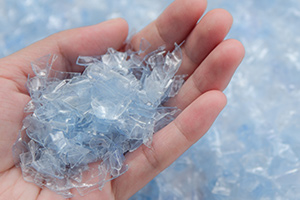 |
PET bottle flakes are recycled plastic flakes obtained by crushing and washing waste PET bottles. They are typically 2–3 mm thick, 3–12 mm long, and come in colors such as transparent (colorless), green, blue, and white. PET bottle flakes: lightweight, highly transparent, and resistant to breakage, they can be used as raw materials for strapping or fiber products. |
Production Process from Waste PET Bottles to PET Bottle Flakes
Obtaining clean PET flakes involves several key steps. First, the collected waste PET bottles are fed into the factory, where a bale breaker opens the packed bottles and removes caps, labels, and other non-PET impurities. Next, the bottle bodies are fed into a crusher and shredded into flakes suitable for downstream applications. The crushed PET flakes are then transferred to a float-sink separation tank for washing. Using the density difference in water, high-density PET flakes sink, while lightweight impurities such as PP caps and labels float and are removed.
After coarse separation, the PET flakes enter a friction washer for deep cleaning. Inside the washer, high-speed blades thoroughly scrub away residual glue and stubborn contaminants on the flake surfaces, ensuring a higher level of cleanliness. Following friction washing, the flakes are conveyed to the next stage—hot water washing.
In the hot water tank, PET flakes are soaked in 99 °C hot water, often with added baking soda, to dissolve and remove residual grease, adhesives, and other organic contaminants.
After hot washing, the flakes are dehydrated using a centrifugal dryer and then dried with a hot-air dryer, reducing the moisture content to below 1%.
Learn more about the PET bottle flakes washing line.
Main Application Areas of PET Bottle Flakes
Thanks to their excellent physical properties and recyclability, PET bottle flakes are widely used across multiple industries:
Packaging Industry: PET flakes can be used to produce new plastic bottles and containers, or extruded into PET sheets and films for food-grade containers, pharmaceutical blister packs, clamshell boxes, packaging trays, and other packaging materials.
Textile Industry: Clean PET flakes are primarily used to manufacture polyester staple fibers and filaments, which are then made into clothing, blankets, carpets, and home textiles.
Building Materials: In the construction sector, PET flakes can be applied to produce plastic lumber, composite boards, insulation materials, roofing tiles, and geotextiles.
Automotive Industry: PET flakes are used in automotive manufacturing for interior components, carpet linings, seat fabrics, and soundproofing materials.
Additionally, PET flakes can be processed into plastic woven bags and other products, or blended with PE to form rigid PET/PE alloys for molded parts—demonstrating the versatile applications of PET flakes.
Different Types of PET Bottle Flakes
PET bottle flakes can be categorized into cold-washed flakes and hot-washed flakes. Cold-washed PET flakes are primarily cleaned with cold water and mechanical friction, offering low-cost processing and suitable for downstream products with lower quality requirements, such as strapping. Hot-washed PET flakes, on the other hand, are washed in hot water tanks with added alkaline solution (commonly NaOH), which effectively removes grease and adhesives, resulting in higher-purity flakes suitable for a wide range of recycling applications.
In addition to washing methods, finished PET flakes are also classified into fiber-grade and food-grade -- (PET flake grades).

 EN
EN 
 English
English 简体中文
简体中文 Русский
Русский España
España عرب .
عرب .